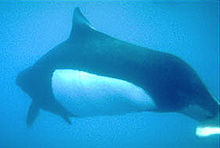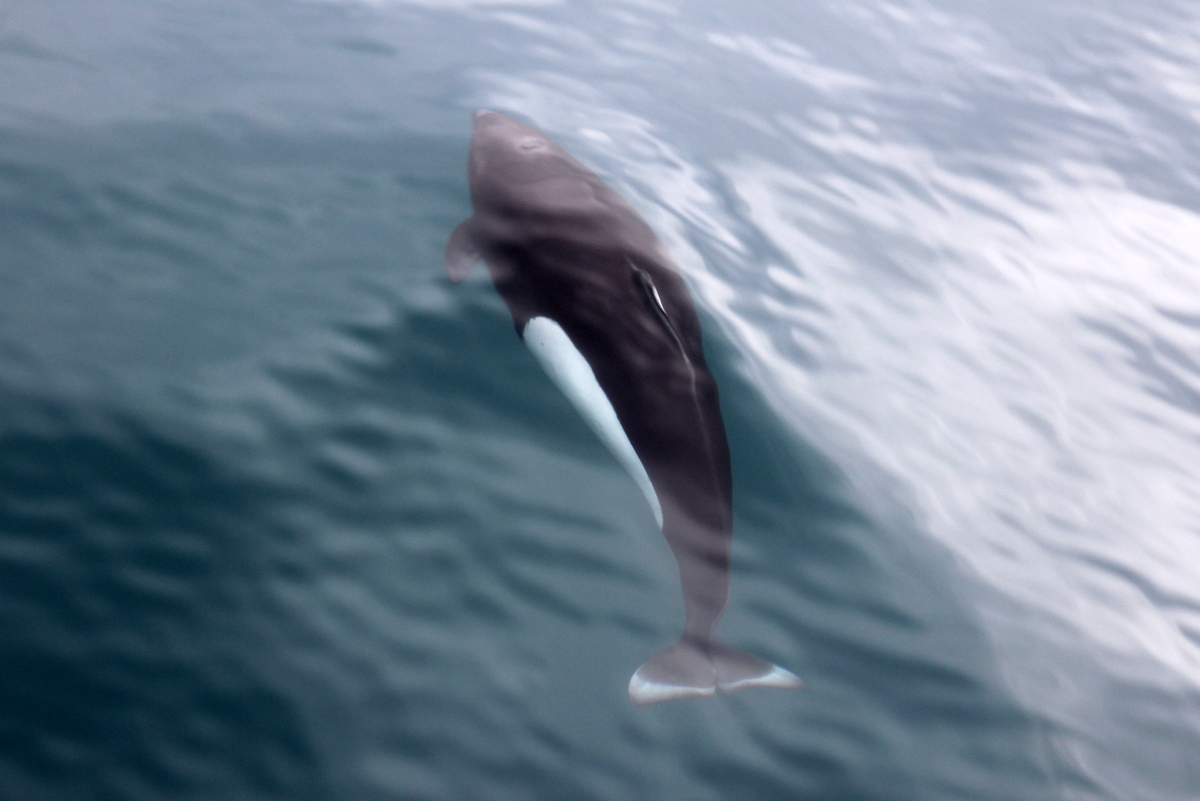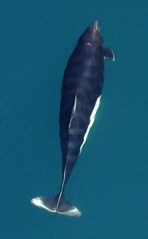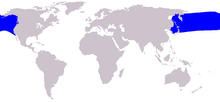
Physical description
The unique body shape of Dall's porpoise makes it easily distinguishable from other cetacean species. The animal has a very thick body and a small head. The colouration is rather like that of a killer whale; the main body of the porpoise is very dark grey to black creeper, with very demarcated white patches on the flank and belly. The dorsal fin is set just back from the middle of the back and sits up erect. The upper part of the dorsal fin has a white to light grey "frosting".The fluke has a similar frosting. The adult fluke curves back towards the body of the animal, which is another distinguishing feature. It is larger than other porpoises, growing up to 2.3 m (7.5 ft) in length and weighing between 130 and 220 kg (290 and 490 lb).[3] There is also sexual dimorphism in the species, with males being larger, having a deeper caudal peduncle and a pronounced hump behind the anus.[3] Young Dall's have a greyish tint and dark-colored flukes.
Population and distribution
Dall’s porpoise prefers cold waters more than 180 metres (590 ft) deep .[3] It is found over the continental shelf adjacent to the slopes and oceanic waters.[6] While it mostly lives in offshore waters, it does occur in deep coastal waters on off North America.[4] There, it typically stays close to deep-water canyons.
Two consistent and well-defined colour morphs, the dalli-type and the truei-type, have been identified. The dalli-type is present throughout the porpoise’s range, while the truei-type lives mostly on the western Pacific and is rare in the east.[3] There is some question as to whether the morphs are merely colour patterns (the truei-type having a more extensive belly patch) or whether they are separate subspecies.[5][7] They are believed to number around 104,000 off Japan, 554,000 in the Okhotsk Sea, 83,000 off Alaska and 100,000 off the continental US.[4]
Ecology and lifestyle
Dall’s porpoises live in small, fluid groups of two to 12.[3] However they can gather in the hundreds when feeding.[3] They have a polygynous mating system in which males will guard females in estrus.[10] During the mating season, a male will select a fertile female and guard her to ensure that he will sire her calf.[10] While guarding, males may sacrifice opportunities to forage in deep dives.[10] Births usually take place in the summer.[4] Porpoise gestation lasts 10 to 11 months, and the lactation period lasts at least two months.[3] Depending on their condition, females can give birth up to every year.[3] Dall's porpoises live for up to 15 years.

Conservation status

Many Dall's porpoises are killed each year as by-catch in fishing nets.[citation needed] A serious cause of concern is the hunting of the species by harpoon by Japanese hunters.[citation needed] The number of porpoise caught each year rose dramatically following the moratorium on hunting larger cetaceans introduced in the mid-1980s. The greatest number were caught in 1988, when more than 40,000 were taken. International attention to the hunt through a 1990 International Whaling Commission (IWC) resolution resulted in a reduction in numbers caught; however, around 15,000 animals are still caught each year, making it the largest direct hunt of any cetacean species in the world. The hunt has been repeatedly criticized by the IWC and its Scientific Committee, most recently in 2008.[12] A quota of just over 16,000 individuals per year is now in effect. In addition, unknown numbers of animals are struck and lost or caught as by catch. Despite these threats, Dall's porpoise remains a fairly common species with productive populations.
Dall's porpoise is listed on Appendix II[13] of the Convention on the Conservation of Migratory Species of Wild Animals (CMS). It is listed on Appendix II[13] as it has an unfavorable conservation status or would benefit significantly from international co-operation organized by tailored agreements.





No comments:
Post a Comment
Note: Only a member of this blog may post a comment.